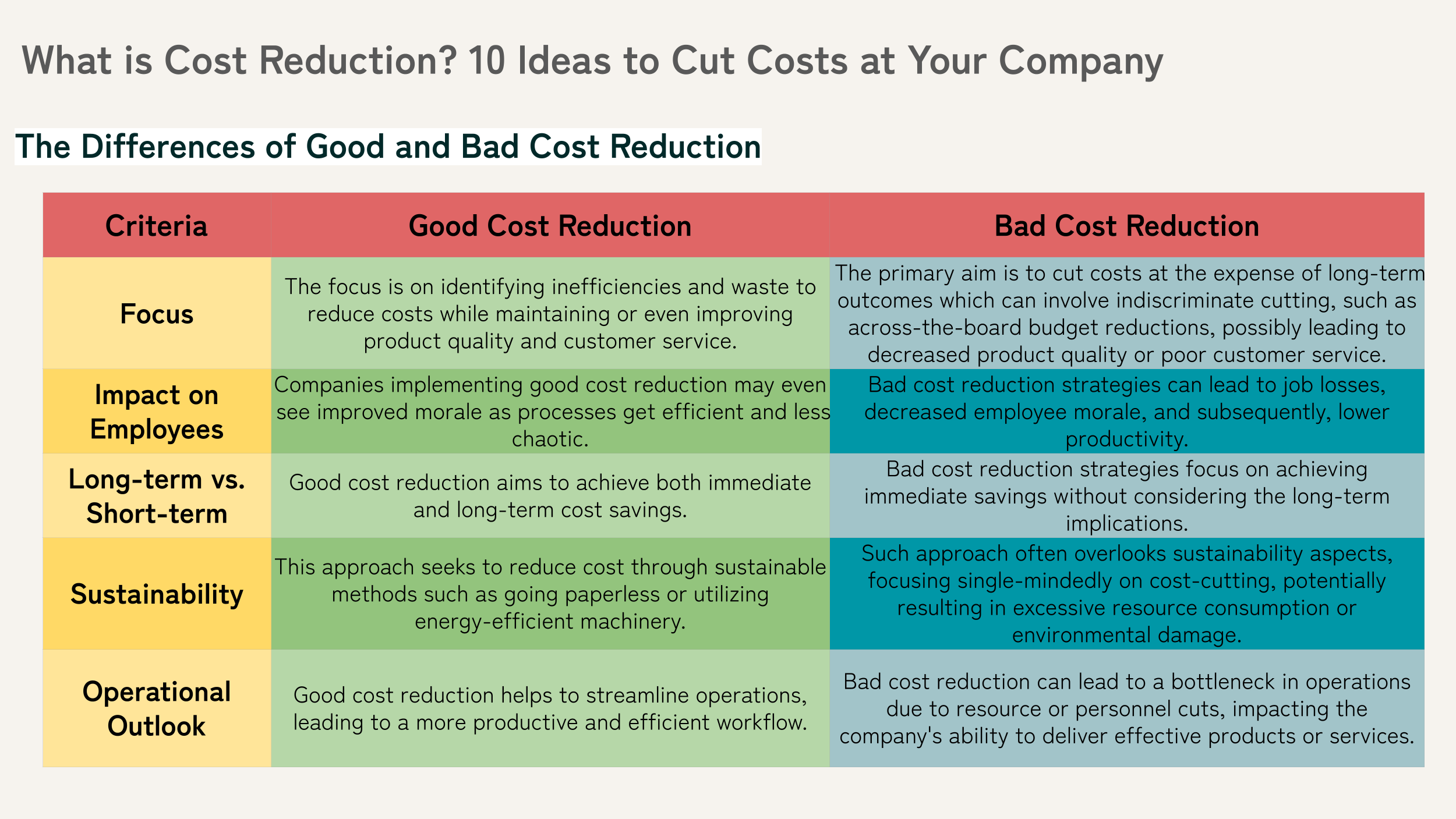
Introduction
In today’s fast-paced and competitive business environment, achieving cost reduction without harming the company’s productivity or product’s quality is the key to a healthy bottom line. Managers are constantly hunting for areas where expenses can be curbed to boost profitability. While this may sound an arduous task to some, a strategic and systematic approach toward cost reduction can pay huge dividends. Throughout this article, we will decipher the term ‘Cost Reduction’, look at the benefits it brings, review the difference between good and bad cost reduction techniques, and most importantly, offer you ten actionable ideas to cut costs at your organization effectively.Understanding Cost Reduction
Cost reduction refers to business strategies aimed at controlling overall costs and improving efficiency within a company. It involves identifying and slashing unnecessary expenditures without compromising the delivered value to customers. These strategies highlight how resources can be deployed more effectively, leading to enhanced profitability, and becoming a crucial element for business survival and growth. It is not merely a slash-and-burn approach to budgeting. Instead, it involves a systematic, organized, and focused approach that targets efficiencies and waste elimination in workflows, supply chains, and resource utilization. For instance, Amazon’s use of robotics in its fulfillment centers is a clear example of strategic cost reduction. These robots have led to a 20% reduction in operating expenses, contributing to Amazon’s competitive edge in low pricing. This example underscores that while cost reduction might imply significant investments initially (such as buying and integrating robots), the long-term cumulative savings often outweigh the upfront expenditure. To conclude, cost reduction is a strategic tool businesses use to improve their bottom lines. It involves a calculated approach towards fine-tuning operational processes, leveraging technology, and eliminating waste to increase efficiencies. The ultimate aim is to ensure that the actions a company takes to reduce expenses contribute positively to its long-term profitability and competitiveness.
The Benefits of Cost Reduction
Cost reduction is an essential component of a successful business strategy. Reducing expenses without compromising operational capacity or product quality can lead to a myriad of benefits, including increased profitability, competitiveness, customer satisfaction, and business growth. In this section, we explore the key benefits of cost reduction:1. Increased Profitability
Arguably the most significant benefit of cost reduction is its impact on a company’s bottom line. Decreasing expenses and efficiently controlling resource usage directly translates to increased profits. A well-documented example is McDonald’s. The fast-food giant utilizes a streamlined supply chain, resulting in substantial cost savings; these savings enable McDonald’s to maintain competitive prices, leading to higher profit margins.2. Enhanced Competitiveness
A business with lean operations and lower operating expenses is better positioned to offer competitive prices, attracting customers and increasing market share. Dell is one such company that implemented numerous cost-saving measures, such as utilizing a direct-to-customer sales model and adopting efficient inventory control systems. These measures helped Dell maintain competitive prices and become a global leader in the computer technology industry.3. Improved Customer Satisfaction
When a company can deliver the same quality product or service at a lower price than competitors, it can substantially increase customer satisfaction. One example worth noting is Netflix’s cost reduction efforts, including infrastructure optimization and bulk content licensing. By lowering its operational costs, Netflix can maintain its subscription rates competitive, leading to increased customer satisfaction and retention.4. Enhanced Agility and Flexibility
When a company streamlines its operations and minimizes extraneous expenses, it becomes more agile and flexible, allowing it to respond more effectively to market changes or unforeseen circumstances. For example, during the pandemic, companies with lower operational expenses, such as those adopting remote work setups, were better poised to navigate the ensuing economic turbulence.5. Greater Efficiency
By focusing on waste elimination and optimized resource utilization, cost reduction drives efficiency. For example, Toyota’s famed “Lean manufacturing” methodology focuses on improving efficiency by seeking out and eliminating wasteful practices. By adhering to these principles, Toyota has bolstered its position as one of the world’s leading automakers.6. Sustainable Business Practices
Cost reduction also promotes environmentally friendly practices, contributing to a business’s social responsibility efforts. By implementing energy-saving solutions and minimizing waste, companies can reduce their environmental footprint while simultaneously curbing expenses.7. Stronger Cash Flow
Effective cost reduction allows a more sound cash flow, offering businesses the resources and financial security to pursue growth opportunities or respond to challenges. Now that we understand what cost reduction implies, let’s explore 10 ideas that your company can implement to smartly cut costs.
Now that we understand what cost reduction implies, let’s explore 10 ideas that your company can implement to smartly cut costs.